To find the perfect antique home decor, start by exploring local antique shops, where you can discover unique pieces and gain insights from knowledgeable owners. Online platforms like eBay and Etsy offer vast selections, but be sure to check reviews and shipping details. Attend antique fairs and estate sales for rare finds and networking opportunities. Regularly visit thrift stores, as they may hide unexpected treasures. Engage with social media platforms and join collector communities for advice and inspiration. Make use of your knowledge of antique styles and craftsmanship to assess authenticity, and always negotiate prices thoughtfully. There's more to uncover in your antique journey.
Key Points
- Visit local antique shops and engage with owners for unique items and insights on authenticity.
- Use specific keywords and seller reviews when exploring online antique markets like eBay and Etsy.
- Attend antique fairs for networking and bargaining opportunities on a wide variety of items.
- Regularly check estate sales and thrift stores for diverse and affordable antique decor pieces.
- Join social media groups and follow dealers for updates on new arrivals and shared antique decor interests.
Research Local Antique Shops

To begin your journey into antique home decor, explore the rich offerings of local antique shops. These shops are treasure troves of unique items, each with a story to tell, adding character and charm to your home. Start by researching shops in your area; local directories, community boards, or word-of-mouth recommendations are invaluable resources. Some antique home decor store websites can also provide insights into popular local spots. Once you have a list, plan a visit to each shop, keeping an open mind about what you might find.
While browsing, engage with shop owners, who often have a wealth of knowledge about their items. Ask about the history, origin, and significance of pieces that catch your eye. This not only enriches your understanding but also helps you make informed decisions. Take your time to inspect each item carefully, looking for signs of authenticity like maker's marks or unique craftsmanship features.
Don't hesitate to negotiate prices; many shop owners expect it and it's part of the experience. Bring a tape measure, ensuring that any furniture or larger items will fit in your intended space. Remember, the goal is to find pieces that resonate with you, enhancing your home with timeless beauty and history.
Explore Online Antique Markets
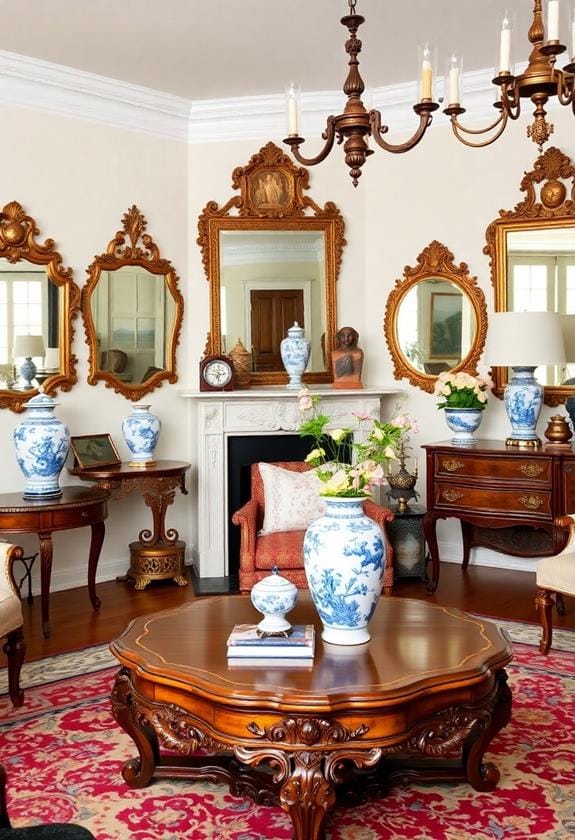
Online antique markets open up a world of possibilities right from the comfort of your home. You can browse through countless items by simply clicking through websites, making it easy to find unique pieces that suit your style. With a variety of options like eBay, Etsy, and specialized antique sites, you're bound to uncover treasures without stepping outside. These platforms often provide detailed descriptions and photos, allowing you to evaluate items thoroughly before purchasing.
To get the most out of online antique markets, it's essential to refine your search skills. Use specific keywords related to the items you desire, like the era or style, to narrow down results. Checking seller reviews is equally important; they give you insights into the reliability and quality of what you're buying. Be aware of shipping costs and return policies, as these can vary greatly between sellers.
Setting a budget helps keep your spending in check, preventing impulse buys. Consider using online alerts for specific items, so you're notified when new listings appear. This proactive approach guarantees you don't miss out on rare finds. By exploring online antique markets, you gain access to an expansive, convenient, and diverse selection, enhancing your home decor journey.
Attend Antique Fairs and Events
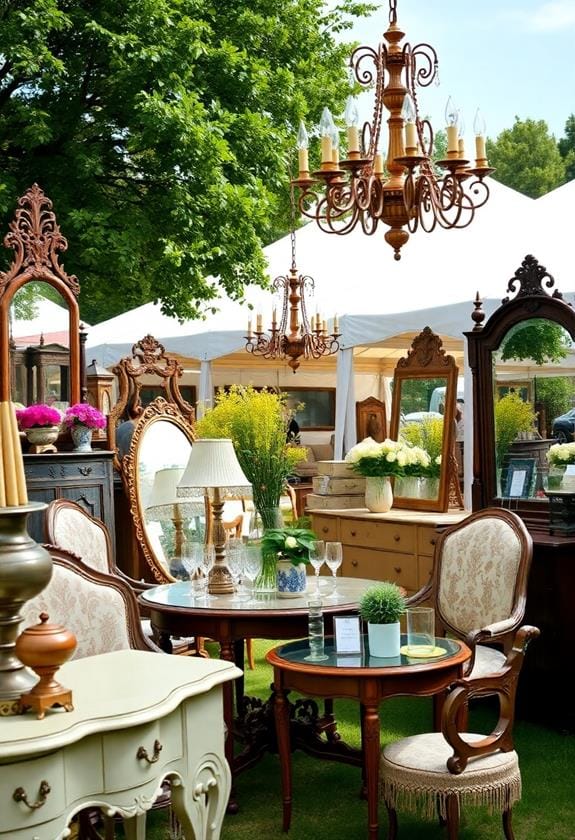
Attending antique fairs and events is an exciting way to immerse yourself in the world of vintage treasures. These gatherings provide a unique opportunity to explore a vast array of items, each with its own story and charm. You'll find that antique fairs are bustling with vendors who are passionate about their collections, offering you a firsthand look at pieces you might not encounter elsewhere.
When you attend these events, keep an eye out for:
- Unique Finds: Discover items that are rare and not easily found in mainstream markets.
- Networking Opportunities: Connect with fellow enthusiasts and experts who can share valuable insights.
- Bargaining Potential: Engage in negotiations to secure your desired items at a fair price.
To make the most of your visit, plan ahead by researching the fairs and events in your area. Arrive early to navigate the space comfortably and get first dibs on the best pieces. Bring along cash for easier transactions, as not all vendors accept cards. By attending these fairs, you're not just buying decor; you're investing in pieces of history, adding character and elegance to your home decor.
Visit Estate Sales
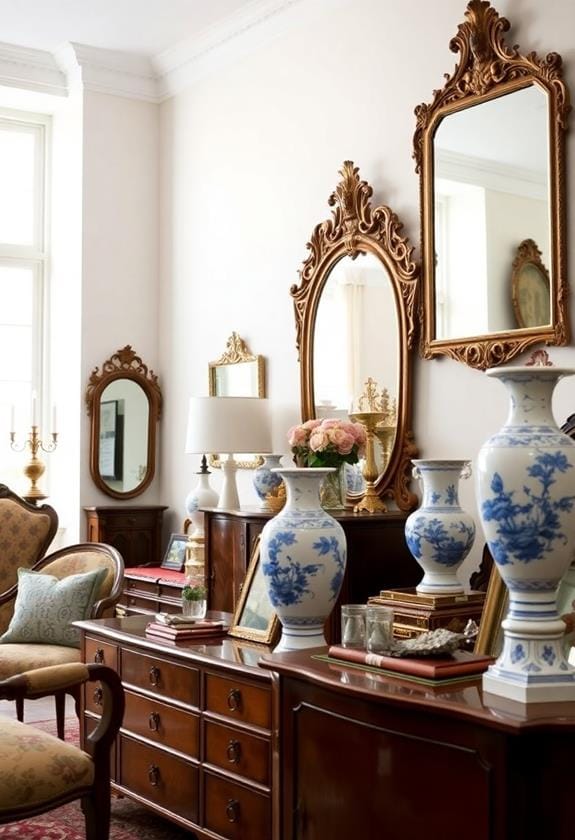
Visiting estate sales offers a fascinating glimpse into the past, allowing you to discover unique home decor items with rich histories. By attending these sales, you can find antiques that tell stories of a bygone era, adding depth and character to your home. Estate sales often feature a diverse array of items, from furniture and art to smaller decorative pieces, all originating from a single household. This makes them a treasure trove for anyone enthusiastic to uncover rare gems with personal significance.
To make the most of estate sales, research sales in your area ahead of time. Websites dedicated to estate sales can provide listings, photos, and descriptions, giving you a sense of what's available. Arriving early is essential, as the most desirable items tend to go quickly. Don't hesitate to ask questions about the history of the pieces—sellers often have fascinating stories to share.
Bring a measuring tape to guarantee the items fit your space, and be prepared to negotiate prices if you're comfortable doing so. Patience and persistence are key; sometimes, visiting multiple sales is necessary to find that perfect piece. Embrace the adventure, and you might just stumble upon a hidden treasure.
Check Out Thrift Stores
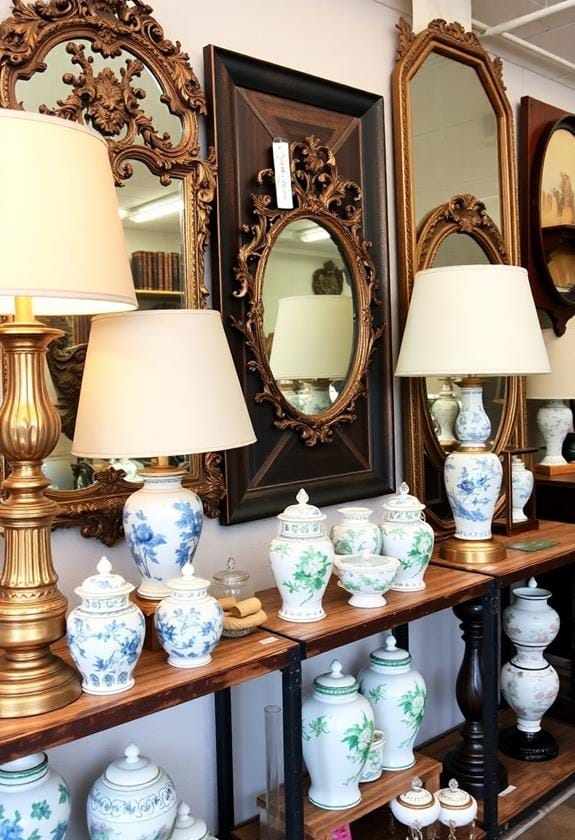
Exploring thrift stores is a fantastic way to find affordable and unique antique home decor pieces. These stores often house hidden gems that add charm and character to your living space. As you wander through aisles brimming with potential, keep your eyes peeled for items that might have been overlooked by others. Thrift stores offer a dynamic shopping experience, where every visit can lead to unexpected treasures. You may even come across charming vintage decor finds that fit any budget, enhancing the excitement of your search.
To make the most of your thrift store visits, consider these tips:
- Go Often: Inventory changes frequently, so regular visits increase your chances of finding something special.
- Inspect Items Thoroughly: Check for damage or authenticity, as some pieces may need minor repairs or verification.
- Be Open-Minded: Sometimes, a fresh coat of paint or a little creativity can transform a seemingly dull piece into a standout decor item.
Network With Collectors
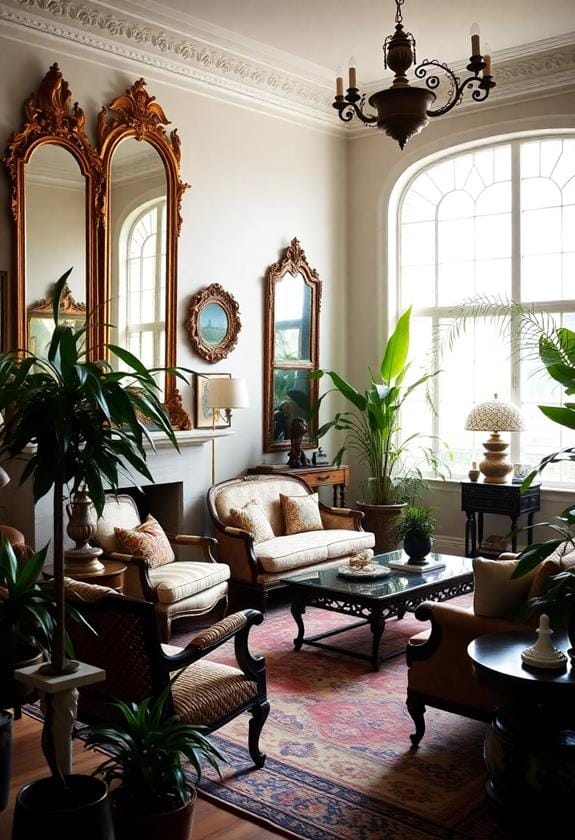
To truly enrich your journey in acquiring antique home decor, you might consider doubling down on networking with collectors. Establishing connections with those who share your passion can provide invaluable insights, helping you uncover hidden gems and broaden your understanding of the antique market. Collectors often have a wealth of knowledge, spanning different eras and styles, which they are usually keen to share. By engaging with them, you can learn to distinguish genuine antiques from reproductions, enhancing your ability to make informed purchases.
Start by attending local antique fairs, auctions, or collector meet-ups in your area. These events offer excellent opportunities to meet seasoned collectors in a casual setting, where conversations about shared interests flow naturally. Don't hesitate to ask questions or seek advice; most collectors appreciate the chance to discuss their passions and will often provide tips on where to find unique pieces.
Additionally, consider joining antique clubs or associations. These groups can connect you with like-minded individuals and provide access to exclusive events and resources. By building a network of collectors, you'll not only enhance your antique home decor collection but also deepen your appreciation and understanding of these timeless treasures.
Utilize Social Media Platforms

While connecting with collectors in person provides valuable insights, don't overlook the power of social media platforms in your quest for antique home decor. These platforms offer a treasure trove of resources and connections that can elevate your search. By tapping into online communities, you can discover unique pieces and gain expert advice without leaving your home. For example, you might even find chic home decor gifts that complement your antique finds perfectly.
Start by exploring platforms like Instagram and Pinterest, where visual inspiration thrives. Here, you'll find countless images of antique decor, styled in various ways, helping you envision how pieces might fit into your space. In addition, these platforms often feature influencers and enthusiasts who share their expertise and favorite finds.
Join groups and forums on Facebook dedicated to antique decor. These spaces are perfect for asking questions, sharing experiences, and buying or selling items. You'll meet like-minded individuals who are enthusiastic to discuss their passion and offer guidance.
- Instagram and Pinterest: Visual inspiration and design ideas.
- Facebook Groups: Community engagement and peer advice.
- Online Marketplaces: Access to a wide variety of antiques.
Study Antique Decor Styles

Delving into the world of antique decor styles opens up a rich tapestry of history and design that can transform your home. By understanding the distinct styles, you can make informed choices that reflect your personal taste while honoring the past. Start with the basics—familiarize yourself with key periods like Victorian, Art Deco, and Mid-Century Modern, each offering unique characteristics and charm. Victorian decor, for example, is known for its ornate details and dark woods, while Art Deco boasts bold geometric patterns and metallic finishes.
To deepen your knowledge, explore books, documentaries, or online resources dedicated to these styles. Pay attention to the materials, colors, and motifs typical of each era. Visiting museums or historical homes can also provide a tangible sense of these styles in their natural settings.
Consider joining antique decor groups or forums where enthusiasts share insights and advice. Engaging with a community can offer perspectives you might not find elsewhere. As you study, think about how these styles can coexist with modern elements in your home, creating a harmonious blend that suits your lifestyle. This understanding not only enriches your decor choices but also connects you with time-honored traditions.
Inspect Items for Authenticity
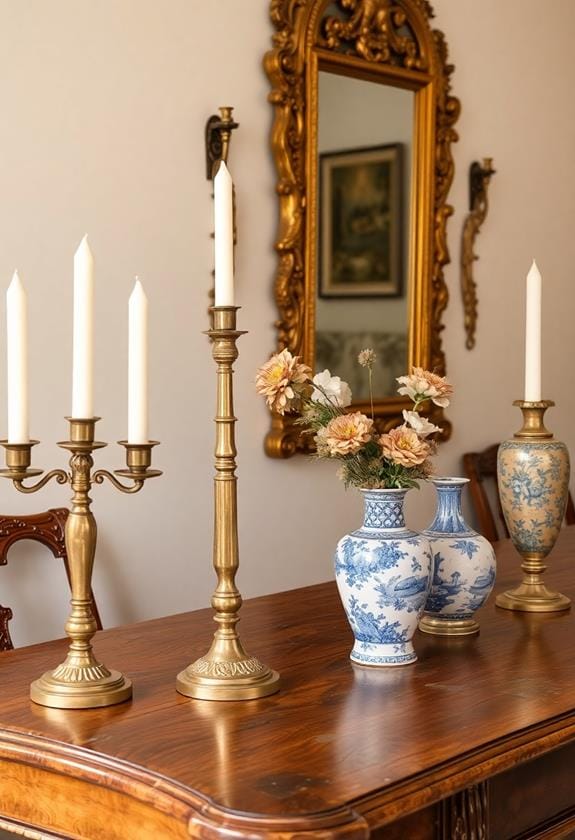
Authenticity is key when incorporating antique items into your home decor. It guarantees that each piece has a genuine history, adding depth and character to your space. Start by examining the item's craftsmanship. Genuine antiques often show signs of age, like slight imperfections or wear, which contribute to their charm. If an item seems too perfect, it might be a reproduction.
Pay attention to the materials used. Older items might feature materials that are less common today. For example, you might find solid wood or hand-blown glass, which can indicate authenticity. Take note of any markings or signatures, as these can provide valuable clues about the item's origins.
Here are a few tips to help you assess authenticity:
- Check for maker's marks: These can reveal the manufacturer and date of production.
- Look for signs of wear: Genuine antiques usually have some wear, such as patina or small scratches.
- Research the item's history: Knowledge about the period and style can help confirm its authenticity.
Trust your instincts and do your research. By carefully inspecting items, you'll be better equipped to find authentic antiques that enhance your home's unique style.
Negotiate Prices Wisely
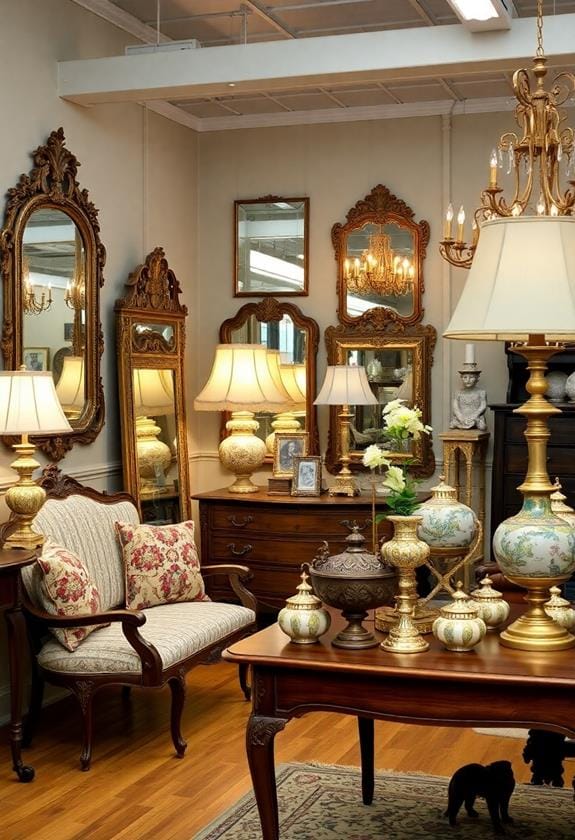
When it comes to negotiating prices for antique home decor, don't be afraid to speak up and advocate for a fair deal. Start by doing your homework; research the item's typical market value to understand its worth. This knowledge arms you with the confidence to negotiate effectively. When discussing price, be polite yet assertive, ensuring you convey respect for the seller while making your case.
It's important to express genuine interest in the item, as this can often encourage the seller to ponder your offer more seriously. If you notice any flaws or damage, point them out tactfully, using them as leverage for a better price. Remember, sellers expect some negotiation, so they might have already priced items with wiggle room.
Be ready to walk away if the price doesn't meet your budget or expectations. Sometimes, the act of leaving can prompt the seller to reconsider and offer a better deal. Finally, practice patience. Negotiating isn't always a quick process, and rushing could lead to missed opportunities. By staying calm and persistent, you'll increase your chances of acquiring beautiful antique decor at a price that suits you.
Frequently Asked Questions
How Can I Determine the Historical Significance of an Antique Decor Item?
You can determine the historical significance of an antique decor item by researching its origin, materials, and craftsmanship. Start by examining any maker's marks or labels, which can provide clues about the item's age and origin. Use online databases or consult reference books to match these details. Additionally, seek out expert appraisals or join antique forums where experienced collectors share insights. This approach will help you appreciate the item's historical and cultural context.
What Are Some Signs of a Well-Maintained Antique Piece?
Imagine a vintage piece glowing like a gem in a treasure chest; signs of good maintenance include a smooth finish without cracks, original hardware, and vibrant colors. You should look for consistent patina, indicating age without neglect. Check for sturdy joints and minimal repairs, as over-restoration can diminish value. Trust your senses—listen for solid sounds when tapped and feel for weight, ensuring the piece isn't deceptively lightweight or fragile.
How Should I Display Antique Decor to Enhance Its Aesthetic Appeal?
When displaying antique decor, you'll want to position each piece thoughtfully to boost its charm. Use varied heights and textures to create visual interest, mixing materials like wood and metal. Guarantee proper lighting, highlighting intricate details without overpowering them. Group similar items, but avoid clutter. Consider the backdrop; neutral tones can make antiques stand out. Rotate pieces occasionally to keep the display fresh, allowing each item to shine in its own right.
What Are the Best Practices for Preserving Antique Home Decor?
To preserve your antique home decor, you should keep items out of direct sunlight, which can cause fading and damage. Use a soft, dry cloth for dusting, avoiding harsh chemicals that might harm delicate surfaces. Maintain a consistent temperature and humidity level to prevent warping or cracking. If possible, display items in stable areas where they're less likely to be knocked over. Regularly check for signs of wear, addressing issues promptly.
How Do I Insure My Antique Home Decor for Protection Against Damage or Loss?
When it comes to insuring your antique home decor, don't put all your eggs in one basket. First, have your pieces professionally appraised to determine their value. Then, shop around for an insurance policy that covers both damage and loss, ensuring it includes specialized coverage for antiques. Keep detailed records, including photographs and receipts, to support any future claims. Regularly update your policy as the value of your antiques changes over time.




